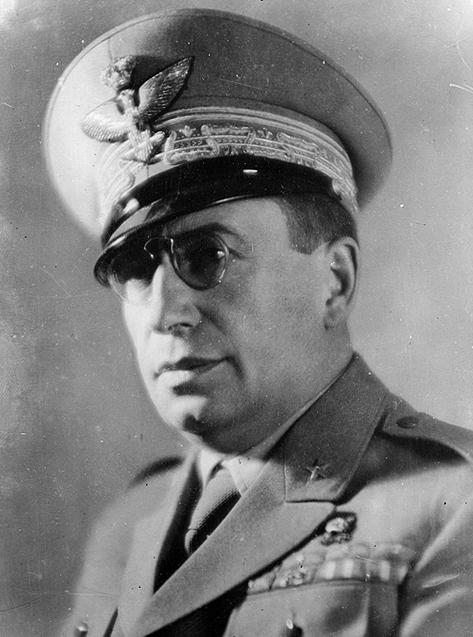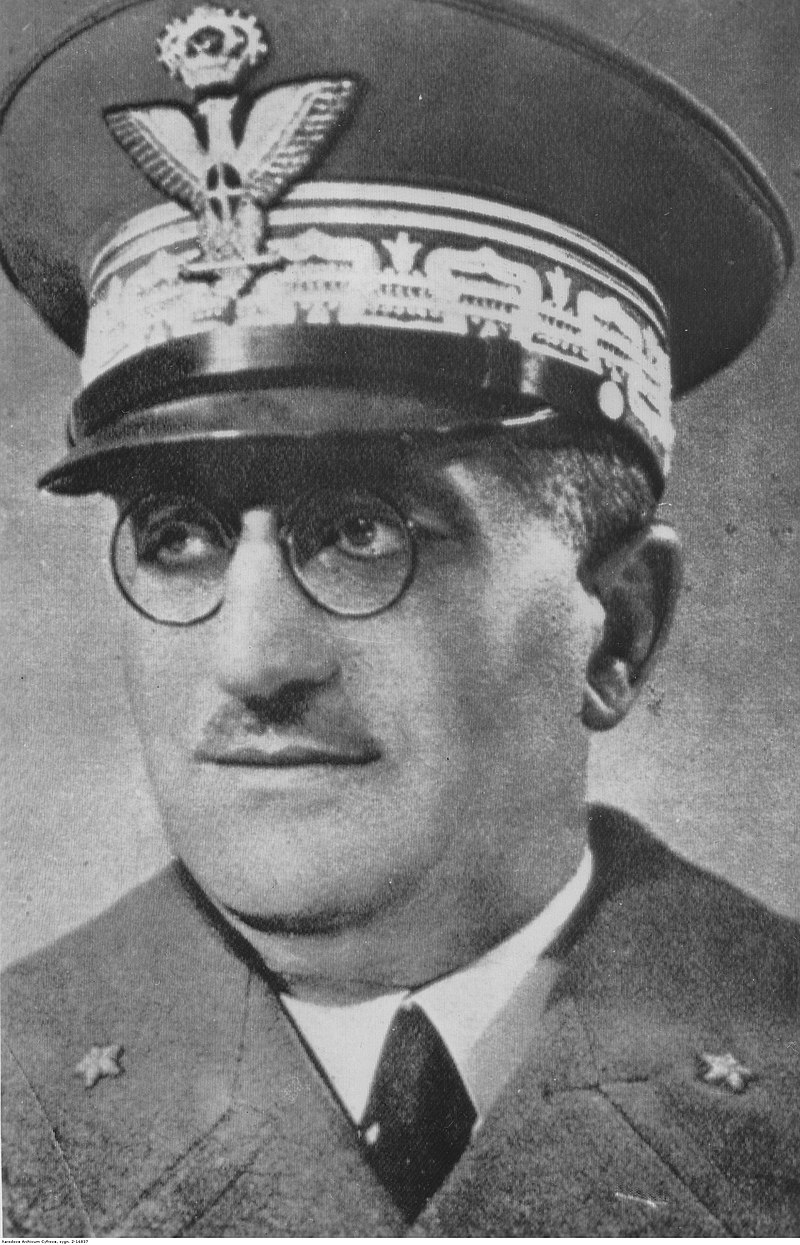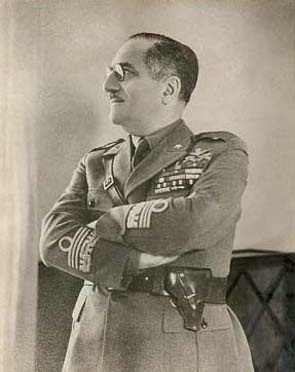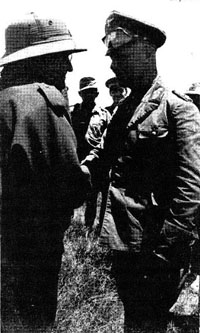<Back to Index>
- Chief-of-Staff of the Italian Army General Mario Roatta, 1887
- Chief of the Italian Supreme Command Maresciallo d' Italia Ugo Cavallero, 1880
PAGE SPONSOR

Mario Roatta (2 February 1887 – 7 January 1968) was an Italian general, best known for his role in Italian Second Army's repression against civilians, in the Slovene - and Croatian - inhabited areas of the Italian - occupied Yugoslavia during World War II. In his Circular 3C, Roatta ordered summary executions, hostage taking, reprisals, internments, burning of houses and whole villages, and the deportation of 25,000 people, who were placed in Italian concentration camps at Rab, Gonars, Monigo (Treviso), Renicci d'Anghiari, Chiesanuova and elsewhere. The survivors received no compensation from the Italian state after the war. The deportees had formed about 7.5 percent of the total population of the Italy-occupied Province of Ljubljana.
From 1934 to 1936, Roatta was the head of the Italian Military Information Service. During the Spanish Civil War, he led the Corpo Truppe Volontarie and helped Francisco Franco's forces. He was the Deputy Chief of Staff of the Italian Army from October 1939 to March 1941 and from March 1941 to January 1942 its Chief of Staff and helped in preparing for the invasion of Yugoslavia. From January 1942 until February 1943, he served as the commander of the Italian Second Army and operated in Yugoslavia. There he constructed a policy in which he attempted to eliminate the Yugoslav Partisans, helped manage relations with the authorities of the puppet Independent State of Croatia, and "greatly advanced and systematized" collaboration with the Chetniks. He also established the Circular 3C as a "manifesto for repression in the Yugoslav territories", urging "ethnic clearance" be carried out and stressed the need for "complete cleansing" of Slovene-inhabited areas.
Mario Roatta was born 2 February 1887 in Modena, Kingdom of Italy to Giovan Battista Roatta and Maria Antonietta Richard. His father, a native of the province of Cuneo, was a captain in the Royal Italian Army. Roatta became an active soldier in the army and was promoted to the rank of second lieutenant in 1906. He served as a staff officer during World War I. After the war he operated as a military attaché in Warsaw where he remained until December 1930 when he took command of an infantry regiment. In June 1933, he was the Chief of Staff of the Army Corps in Bari and afterwards the Chief of Intelligence of the General Staff. From 1934 to 1936, Roatta headed the Italian Military Intelligence Service (Italian: Servizio Informazioni Militari, SIM).
From September 1936 to December 1938, he took part in the Spanish Civil War.
He initially aided Galeazzo Ciano by helping direct "Italian assistance
to the Nationalists on a day-to-day basis". In 1936 Ciano successfully
persuaded Mussolini that Roatta be given command of the Corps of Volunteer Troops (Corpo Truppe Volontarie, CTV).
In early March 1937, Roatta and his entire CTV were deployed to central
Spain for the Battle of Guadalajara (Operation Folgore) with the
intent of capturing Madrid and causing the collapse of the Second
Spanish Republic. Roatta was later replaced by Ettore Bastico as commander.
From July to October 1939 he served as a military attaché in Berlin. From October 1939 to March 1941, he served as the Deputy Chief of Staff of the Italian Army.
In September 1940, the Italians set forth the first crucial steps
necessary for the invasion of Yugoslavia. Roatta reported that "all
available forces in northern Italy gathered at the Yugoslav frontier
between Tarvisio and Fiume:
two armies on the front line, and a third in reserve. Altogether there
were thirty - seven divisions, eighty - five groups of medium caliber
artillery, and all the special formations, with corresponding services
and supplies."
In January 1942, Roatta had become the commander of the Italian Second Army, succeeding General Vittorio Ambrosio.
Between 30 January and 9 February 1942, Roatta discussed with Ambrosio to create a Policy Directive (Linea di condotta) on his command's relationship with the Croats, Chetniks, and Partisans. Roatta was mostly concerned with removing a large number of Italian forces present in Zones II and III and reorganizing those left into strong garrisons to lower troop casualties. In a response sent on 13 February, Ambrosio stated that there should be maximum loyalty to the Croats, but with a "no uncertainty, or weakness, and a strong hand, if necessary." He vowed a "struggle to the bitter end" with regards to the Partisans. Through these talks the relationship with the Independent State of Croatia and the Partisans was well defined. Under Mario Roatta's command, Italy's violence against the Slovene civil population matched the Germans. Executions, hostage taking and killing, reprisals, internments into the Rab and Gonars concentration camps, and the burning of houses and villages were ordered. According to historians James Walston and Carlo Spartaco Capogeco, the annual mortality rate in the Rab concentration camp was higher than the average mortality rate in Nazi concentration camp Buchenwald (which was 15%), at least 18 percent. Monsignor Joze Srebnic, Bishop of Veglia (Krk island), reported to Pope Pius XII that "witnesses, who took part in the burials, state unequivocally that the number of the dead totals at least 3,500".
With the Chetniks, however, Roatta was free to create his own policy and collaboration between the two was "greatly advanced and systematized" under his supervision and carried out by all Italian commanders in the Italian annexed or occupied areas of Yugoslavia.
On 1 March 1942, Roatta issued the Circular 3C which was distributed to ranks up to battalion command in areas occupied and annexed by the Italians. It was a "manifesto for repression in the Yugoslav territories" that urged mass internment and a scorched earth strategy in order for "de-Balkanization" and "ethnic clearance". There was no resistance from the High Command of the Second Army for the "evacuation of entire regions." In "abnormal" (areas where military action was taking place) occupied districts, Roatta demanded that all families that, without good reason, lacked their able-bodied male members between the ages of sixteen and sixty years, be interned and deported. He justified this mass internment with the intense danger that the rebels posed. Suspicious groups were to be identified, taken as hostage, and kept in custody. When attacks were carried out against the Italians and perpetrators weren't identified within forty-eight hours the hostage were to be executed. Residents near railway lines, roads, telephone lines, and military depots were to be implicated in sabotage acts and if information that led to an arrest within forty - eight hours was not provided, they would be interned, their cattle confiscated, and their houses destroyed. Roatta also demanded that all males, able-bodied or wounded, near rebel groups to be seen as insurgents if they wore military uniforms, had band badges, or carried military equipment.
In addition there were "ten commandments" stipulating that:
- The army is fighting a war.
- The information service must be particularly active and extensive.
- Secrecy must be maintained at all costs.
- Garrisons large and small must be organized for defense.
- The efficiency of the rebels is often overestimated.
- You must react promptly against enemy offensives, using as much massive force as possible.
- Operations against the rebels are real and proper acts of war.
- Being caught off-guard is unacceptable.
- You must tenaciously fight to the bitter end.
- The situation and prestige of Italy in the new provinces, and in the occupied territories, require iron discipline from the entire army and demeanor in every respect exemplary.
On 6 March 1942, in a report to the General Staff of the Army, he created a policy towards the Chetniks with four points:
To support the Chetniks sufficiently to make them fight against the communists, but not so much as to allow them too much latitude in their own action; to demand and assure that the Chetniks do not fight against the Croatian forces and authorities; to allow them to fight against the communists on their own initiative (so that they can "slaughter each other"); and finally to allow them to fight in parallel with the Italian and German forces, as do the nationalist bands [Chetniks and separatists] in Montenegro.
Roatta later explained his policy in more detail in his postwar memoirs:
The political label of the "Chetniks," their indirect relations with the "Allies," and their program for the future did not interest this commander, and these things he "ignored." He only established and exploited the existing fact, that in the territory under his command the "Chetniks" acted in our favor. So much the worse for the Croats and the Germans in other regions who did not want to or did not know how to make out of the "Chetniks" their own allies. Thus, despite the protests of Berlin and Zagreb, and the efforts of the government in Rome (which often changed its opinion and finally adopted the German view), we continued on our part to collaborate with the "Chetniks." The formations in question were furnished arms, etc., and so regularized (as were the other voluntary formations) until they reached a total strength of about 30,000 men.
On 23 May 1942, Roatta met with Mussolini who told him that "the best
situation is when the enemy is dead. So we must take numerous hostages
and shoot them whenever necessary." To implement this in Province of
Ljubljana, Roatta suggested the closure of the Fiume province
and Croatia, the evacuation of people in the east of the former
frontiers to a distance of three to four kilometers inland, the
organization of border patrols to kill anyone attempting to cross, the
mass internment of "twenty to thirty thousand persons" to Italian concentration camps, burning down houses, and the confiscation of property from villagers suspected of having contact with Slovene Partisans
for families of Italian soldiers. He also mentioned the need to extend
the plan to Dalmatia and for the construction of concentration camps.
Roatta insisted, "If necessary don't shy away from using cruelty. It
must be a complete cleansing. We need to intern all the inhabitants and
put Italian families in their place."
On 19 June 1942, an Italian-Croatian agreement was formalized in Zagreb regarding the withdrawal of around half the Italian forces present in Zones II and III, leaving the Croatian government to maintain the Chetnik militias established there by the Italians – provided that the Chetniks recognized the sovereignty of the Independent State of Croatia.
Since September 1942 the Chetniks attempted to persuade the Italians into carrying out a "large operation" within their occupation zone. Roatta met with Chetnik leader Ilija Trifunović - Birčanin on September 10 and 21. Trifunović - Birčanin urged him to take action "as soon as possible" in a large operation against the Yugoslav Partisans in the Prozor - Livno area and offered aid in the form of 7,500 Chetniks on the condition that they be provided the necessary arms and supplies. In the meeting on September 10, Trifunović - Birčanin told Roatta that he was not under the command of Draža Mihailović, but that he had seen him on July 21 in Avtovac and had his approval in collaborating with the Italians. In late September or early October, Mihailović, responding to a letter from Trifunović - Birčanin dated September 20, congratulated him on his conduct and "high comprehension of the national line" in these talks.
On 16 September 1942, Roatta reported to the Italian Supreme Command (Comando Supremo) that he had a total of 12,320 Chetniks under his command and the possibility of arming 6,000 more. By February 1943 there were 20,514 Chetniks under the command of the Italian Second Army.
In early October the Italian - Chetnik offensive Operation Alfa was launched and targeted Partisans northwest of the middle part of the Neretva. Between 3,000 – 5,500 Chetniks took part in the operation and were under the command of Petar Baćović and Dobroslav Jevđević. On 14 - 15 October 1942, while in progress of the operation, the Chetniks massacred 543 Catholic and Muslim civilians on the pretense that they harbored and aided the Partisans. Roatta objected to these "massive slaughters" of noncombatant civilians and threatened to halt Italian aid to the Chetniks if they did not end and stated that "I request that Commander Trifunović be apprised that if the Chetnik violence against the Croatian and Muslim population is not immediately stopped, we will stop supplying food and daily wages to those formations whose members are perpetrators of the violence. If this criminal situation continues, more severe measures will be undertaken."
On 10 October 1942, Mladen Lorković, Croatian minister of foreign affairs, wrote a letter and memorandum concerning the increase in Chetnik anti - Croatian activity and terror that occurred between August and September, especially in Herzegovina, central Dalmatia, and Lika. He repeated three demands: the removal of Chetniks from areas in which Catholics and Muslims resided; the removal of Serbian and Montenegrin Chetnik commanders from their posts; and the severe punishment of Chetniks that did not obey "the life, property, and honor of Croatian citizens and against the dignity of the Croatian state." A few days later on 15 October, Roatta held talks with Pavelić in Zagreb and primarily discussed the Chetniks and the handover of Jews to German or Croatian authorities. Roatta did not directly address the transfer of Jews and ultimately few were sent. In regard to the Chetniks, he promised to fulfill previous Croatian requests. On 31 October 1942, in response to the letter of protest by Lorković, Roatta claimed that the acts were not of "mass character" and that they were carried out by individuals and small groups uncontrolled by the MVAC or carried out by the communists. He denied that the Italians supported any terrorist activity against the Croats and that intervention urging peace was undertaken when they had witnessed them.
On 16 December 1942, Adolf Hitler ordered the Armed Forces Commander
in South - East Europe, Generaloberst Alexander Löhr to crush the
resistance in Yugoslavia and on 8 January 1943, Roatta and Löhr met in Zagreb where they devised a detailed plan for Case White.
Near the end of February 1943, Roatta was replaced by General Mario
Robotti, commander of Italian troops in Slovenia, as commander of the
Second Army. Roatta returned to his post of Chief of Staff of the Italian Army in June.
Robotti vigorously implemented Roatta's Circular 3C while in power and
in September work on a permanent barricade that would encircle Ljubljana was begun.
On 10 November 1943, the Allies requested that Italian Marshal Pietro Badoglio remove Roatta from his post as Chief of Staff of the Italian Army due to Yugoslavia's charges that he committed war crimes. On 12 November, Roatta was dismissed from his post. Yugoslavia unsuccessfully requested Roatta's extradition, and he along with other suspected Italian war criminals were never tried. The British government frustrated such requests due to their attempt to bolster the anti-communist position of the post-war Italian government. Historian Alessandra Kersevan and journalist Rory Carroll have accused the Italian public and media of repressing their collective memory of the atrocities committed during World War II, and of "historical amnesia", citing the forgiveness of Roatta and the jailing of two Italian filmmakers, who depicted the Italian invasion of Greece, as examples of historical revisionism.
On 5 March 1945, Roatta escaped from the Virgilio Army Hospital in Rome. A reward of one million lire ($10,000) was offered for his capture. The following day a "mild mass meeting" took place at the Italian royal palace in protest of his escape and escalated into a riot ending with one person dead. On 4 April, Sergeant Stuart W. Mathes put up a personal reward of $20,000 for Roatta's capture. Roatta fled to Spain, where he lived under the protection of dictator Francisco Franco. In Italy, he was convicted and sentenced in absentia to life imprisonment plus one year of solitary confinement. His sentence was overturned by the Italian High Court of Appeal in 1948. Beginning in 1964, a number of Roatta's works were published. He returned to Rome in 1966, and lived there until his death on 7 January 1968.



Ugo Cavallero (September 20, 1880 – September 13, 1943) was an Italian military commander before and during World War II. He was also a recipient of the Knight's Cross of the Iron Cross (German: Ritterkreuz des Eisernen Kreuzes). The Knight's Cross of the Iron Cross was awarded by the Third Reich to recognize extreme battlefield bravery or successful military leadership.
Born in Casale Monferrato, Piedmont, Cavallero had a privileged childhood as a member of the Italian nobility.
After attending military school, Cavallero was commissioned a Second Lieutenant in 1900.
Cavallero later attended college and graduated in 1911, earning a degree in mathematics.
Still in the army, Cavallero fought in Libya in 1913, during the Italo - Turkish War, and was awarded a Bronze Medal for Military Valor.
In 1915, Cavallero was transferred to the Italian Supreme Command. A brilliant organizer and tactician, Cavallero became a Brigadier General and Chief of the Operations Office of the Italian Supreme Command in 1918. In this capacity, Cavallero was instrumental in forming plans that led to Italian victories at Piave and Vittorio Veneto during World War I. During his time as chief of the planning division of the Italian General Staff, he developed an antipathy towards Pietro Badoglio the Sottocapo di Stato Maggiore (vice chief of staff ) of the army.
Cavallero retired from the army in 1919 but later rejoined in 1925, at which time he became Benito Mussolini’s Undersecretary of War. A committed fascist, Cavallero was made a senator in 1926 and in 1927 became a major general. After leaving the army for a second time, Cavallero became involved in business and diplomatic enterprises throughout the late 1920s and early 1930s.
Cavallero rejoined the army for the third and final time in 1937. Promoted to Lieutenant General, he became Commander of the combined Italian forces in Italian East Africa in 1938 and was made a full General in 1940.
After Italy entered World War II in June 1940, Cavallero was made the Commander - in - Chief of the Italian Army Group in Albania. In October, when Italy invaded Greece, he was the commander of the invading Italian forces. In December, he replaced Pietro Badoglio as the Chief of the Italian Supreme Command (Comando Supremo). Italian military activities in Greece remained part of Cavallero's responsibilities and oversight was added immediately of campaigns in the Western Desert and East Africa.
As Chief of the Italian Supreme Command, Cavallero worked closely with German Field Marshal Albert Kesselring and often asked for Kesselring’s advice on military matters. Cavallero opposed Field Marshal Erwin Rommel’s invasion of Egypt and campaigned for Rommel’s dismissal in 1942. But he was ignored by both Adolf Hitler and Benito Mussolini. Under Cavallero’s leadership, Italy’s military forces performed poorly during the war. Nonetheless, he was promoted to Marshal of Italy (Maresciallo d'Italia) in 1942 after the promotion of Rommel to Field Marshal. During his tenure as chief of general staff, his performance was very bad and he became famous for his optimistic view over the course of the war.
In July 1943, after several serious Italian setbacks (such as the Allies’ capture of Libya), Cavallero was dismissed as Chief of the Supreme Command (Commando Supremo) and replaced by Vittorio Ambrosio. In response to Cavallero's dismissal, members of the Fascist leadership like Galeazzo Ciano expressed their joy.
At the same time as Cavallero's dismissal, Mussolini’s government was toppled by the King and Pietro Badoglio was appointed Prime Minister. Cavallero was arrested by Badoglio for his Fascist and pro - German views. In his own defense, Cavallero wrote a letter to Badoglio claiming he despised Mussolini and Fascism. But Badoglio did not believe him.
In September, when Badoglio’s government surrendered to the Allies, the Germans invaded Rome and rescued Cavallero. They planned to make him a commander of Italian military forces still loyal to Fascist ideals. However, the Germans found his anti - Fascist letter in Badoglio’s abandoned office and believed him to be a traitor.
Now hated by both the Germans and by the forces loyal to Badoglio, a desperate Cavallero committed suicide. On 13 September, he shot himself in the head. Whether he did so willingly is still a matter of some debate.